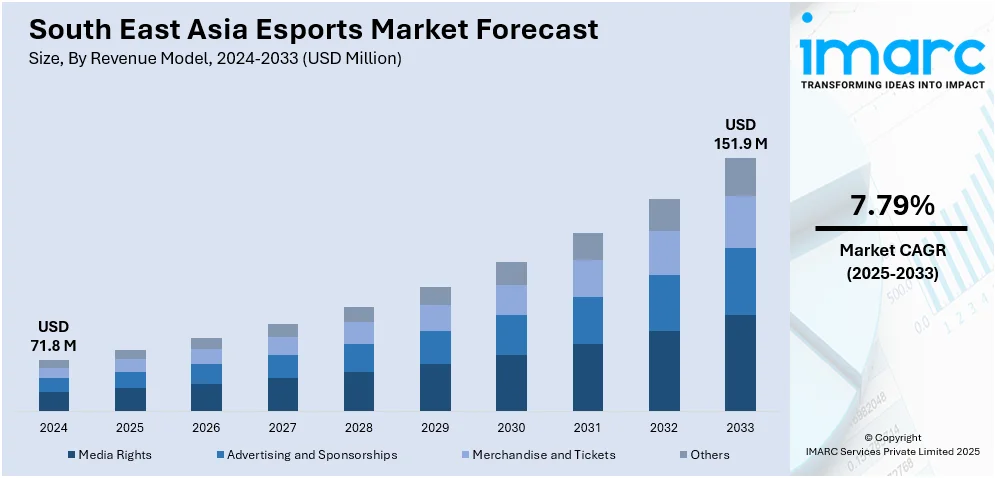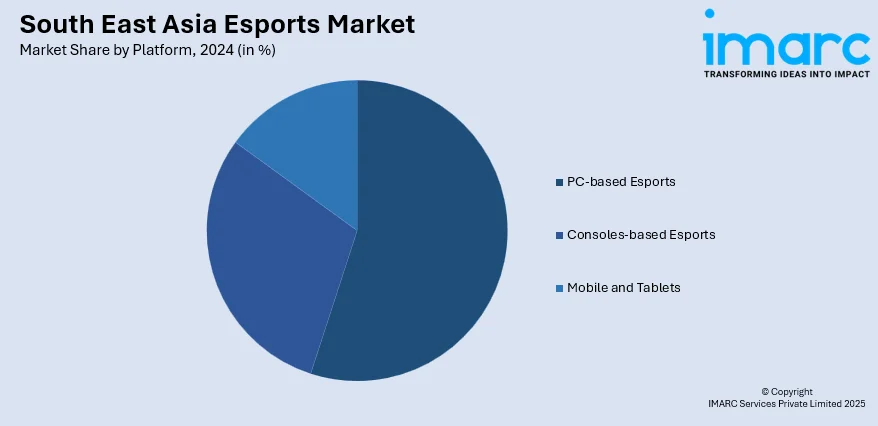
South East Asia Esports Market Size, Share, Trends and Forecast by Revenue Model, Platform, Games, and Country, 2025-2033
Market Overview:
South East Asia esports market size reached USD 71.8 Million in 2024. Looking forward, IMARC Group expects the market to reach USD 151.9 Million by 2033, exhibiting a growth rate (CAGR) of 7.79% during 2025-2033. The increasing advancements in gaming hardware, internet infrastructure, and streaming technology, which have improved the overall gaming experience, making it more accessible and enjoyable for a wider audience, are driving the market.
|
Report Attribute
|
Key Statistics
|
|---|---|
|
Base Year
|
2024 |
|
Forecast Years
|
2025-2033
|
|
Historical Years
|
2019-2024
|
| Market Size in 2024 | USD 71.8 Million |
| Market Forecast in 2033 | USD 151.9 Million |
| Market Growth Rate (2025-2033) | 7.79% |
Esports, or electronic sports, refers to competitive video gaming events where professional players or teams compete against each other in various video games. These events often take the form of organized multiplayer competitions, either individually or as teams, and are typically broadcasted to a live audience. Esports has gained significant traction, fostering a community of dedicated gamers, enthusiasts, and sponsors. Popular games in the esports realm include League of Legends, Dota 2, and Overwatch, among others. Esports has become a lucrative industry, with professional players earning substantial incomes and tournaments offering considerable prize pools. The growth of esports has led to the establishment of professional teams, leagues, and organizations akin to traditional sports structures and has garnered mainstream recognition, drawing the attention of both gamers and non-gamers alike.

To get more information on this market, Request Sample
South East Asia Esports Market Trends:
The esports market in South East Asia is rapidly expanding, primarily driven by various factors. Firstly, the surge in internet penetration and the widespread availability of high-speed internet connections have facilitated the growth of online gaming, thereby fueling the esports industry. Additionally, the increasing accessibility of advanced gaming technologies, such as virtual reality and augmented reality, has attracted a broader audience, leading to heightened engagement and participation. Moreover, the rising popularity of competitive gaming tournaments and leagues, coupled with the advent of organized esports events, has contributed significantly to the market's upward trajectory. Furthermore, the growing influence of social media platforms and streaming services has amplified the visibility of professional gamers and esports competitions, generating substantial interest among both gaming enthusiasts and non-gamers alike. Lastly, the escalating investments from major corporate sponsors, media companies, and venture capitalists, which have bolstered the infrastructure and overall ecosystem, are expected to drive the esports market in South East Asia during the forecast period.
South East Asia Esports Market Segmentation:
IMARC Group provides an analysis of the key trends in each segment of the market, along with forecasts at the country level for 2025-2033. Our report has categorized the market based on revenue model, platform, and games.
Revenue Model Insights:
- Media Rights
- Advertising and Sponsorships
- Merchandise and Tickets
- Others
The report has provided a detailed breakup and analysis of the market based on the revenue model. This includes media rights, advertising and sponsorships, merchandise and tickets, and others.
Platform Insights:

- PC-based Esports
- Consoles-based Esports
- Mobile and Tablets
A detailed breakup and analysis of the market based on the platform have also been provided in the report. This includes PC-based esports, consoles-based esports, and mobile and tablets.
Games Insights:
- Multiplayer Online Battle Arena (MOBA)
- Player vs Player (PvP)
- First Person Shooters (FPS)
- Real Time Strategy (RTS)
The report has provided a detailed breakup and analysis of the market based on the games. This includes multiplayer online battle arena (MOBA), player vs player (PvP), first person shooters (FPS), and real time strategy (RTS).
Country Insights:
- Indonesia
- Thailand
- Singapore
- Philippines
- Vietnam
- Malaysia
- Others
The report has also provided a comprehensive analysis of all the major regional markets, which include Indonesia, Thailand, Singapore, Philippines, Vietnam, Malaysia, and Others.
Competitive Landscape:
The market research report has also provided a comprehensive analysis of the competitive landscape. Competitive analysis such as market structure, key player positioning, top winning strategies, competitive dashboard, and company evaluation quadrant has been covered in the report. Also, detailed profiles of all major companies have been provided.
South East Asia Esports Market Report Coverage:
| Report Features | Details |
|---|---|
| Base Year of the Analysis | 2024 |
| Historical Period | 2019-2024 |
| Forecast Period | 2025-2033 |
| Units | Million USD |
| Scope of the Report | Exploration of Historical Trends and Market Outlook, Industry Catalysts and Challenges, Segment-Wise Historical and Future Market Assessment:
|
| Revenue Models Covered | Media Rights, Advertising and Sponsorships, Merchandise and Tickets, Others |
| Platforms Covered | PC-based Esports, Consoles-based Esports, Mobile and Tablets |
| Games Covered | Multiplayer Online Battle Arena (MOBA), Player vs Player (PvP), First Person Shooters (FPS), Real Time Strategy (RTS) |
| Countries Covered | Indonesia, Thailand, Singapore, Philippines, Vietnam, Malaysia, Others |
| Customization Scope | 10% Free Customization |
| Post-Sale Analyst Support | 10-12 Weeks |
| Delivery Format | PDF and Excel through Email (We can also provide the editable version of the report in PPT/Word format on special request) |
Key Benefits for Stakeholders:
- IMARC’s industry report offers a comprehensive quantitative analysis of various market segments, historical and current market trends, market forecasts, and dynamics of the South East Asia esports market from 2019-2033.
- The research report provides the latest information on the market drivers, challenges, and opportunities in the South East Asia esports market.
- Porter's five forces analysis assist stakeholders in assessing the impact of new entrants, competitive rivalry, supplier power, buyer power, and the threat of substitution. It helps stakeholders to analyze the level of competition within the South East Asia esports industry and its attractiveness.
- Competitive landscape allows stakeholders to understand their competitive environment and provides an insight into the current positions of key players in the market.
Key Questions Answered in This Report
The esports market in South East Asia was valued at USD 71.8 Million in 2024.
The South East Asia esports market is projected to exhibit a CAGR of 7.79% during 2025-2033, reaching a value of USD 151.9 Million by 2033.
As mobile gaming is becoming more accessible and affordable, millions of players across the region are participating in online multiplayer games that serve as a gateway to esports. The strong influence of streaming platforms, social media, and gaming influencers is fueling interest and engagement in esports tournaments and content. Additionally, government support and private investments are helping build infrastructure, such as esports arenas, training facilities, and gaming academies.
Need more help?
- Speak to our experienced analysts for insights on the current market scenarios.
- Include additional segments and countries to customize the report as per your requirement.
- Gain an unparalleled competitive advantage in your domain by understanding how to utilize the report and positively impacting your operations and revenue.
- For further assistance, please connect with our analysts.
 Request Customization
Request Customization
 Speak to an Analyst
Speak to an Analyst
 Request Brochure
Request Brochure
 Inquire Before Buying
Inquire Before Buying




.webp)




.webp)












